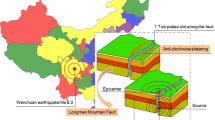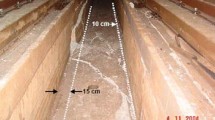Abstract
Throughout construction process of a tunnel in an active tectonic region, it may be impossible to avoid active faults. Active faults create two adverse effects on the tunnels which are sudden fault displacement and weak ground conditions in fault zone. If a tunnel crossed by an active fault, the tunnel might be damaged by sudden movement of the fault. However, the main goal is to localize this damage without complete loss of tunnel. In this study, a special design developed for a wide span tunnel cut by an active fault is presented and the performance of the design is verified by numerical analyses. T9 tunnel was constructed within the scope of Ankara–Sivas High-Speed Train Project, Turkey, and the special design at the intersection of T9 tunnel with the Akdagmadeni active fault is the main subject of this study. T9 tunnel predominantly passes through agglomerate, basalt, marble and gneiss units and the tunnel route crosses the Akdagmadeni fault at around Km: 327 + 915. At this location, major deformations occurred in the tunnel and the tunnel excavation had to stop for a certain period. After the re-design phase, a special tunnel support system for this location were developed and proposed design was analyzed with numerical analyses. In addition, the possible displacement of the Akdagmadeni fault was estimated and the inner lining was re-designed considering the seismic parameters (i.e. peak ground acceleration and maximum displacement during a large earthquake). Consequently, in the present study, the effects of active fault crossing on the tunnel were explained and a special inner lining design was proposed to localize the possible damages, which are originated from the sudden displacement of the active fault.
























Similar content being viewed by others
References
Akgün H, Muratlı SW, Koçkar MK (2014) Geotechnical investigations and preliminary support design for the Geçilmez tunnel: a case study along the Black Sea coastal highway, Giresun, northern Turkey. Tunn Undergr Space Technol 40:277–299
Aygar E (2000) Critical approach to the new Austrian tunneling method in Bolu tunnels. MSc Thesis. Hacettepe University, Ankara
Aygar E (2007) Investigation of the Bolu Tunnel stability by means of static and dynamic analyses. PhD Thesis. Hacettepe University, Ankara
Azizkandi AS, Ghavamia S, Baziar MH, Hasanaklou SH (2019) Assessment of damages in fault rupture–shallow foundation interaction due to the existence of underground structures. Tunn Undergr Space Technol 89:222–237
Barton NR, Lien R, Lunde J (1974) Engineering classification of rock masses for the design of tunnel support. Rock Mech 6(4):189–239
Barton N, Løset F, Lien R, Lunde J (1980) Application of the Q-system in design decisions. In: Bergman M (ed) Subsurface space, vol 2. Pergamon, New York, pp 553–561
Bieniawski ZT (1973) Engineering classification of jointed rock masses. Trans South Afr Inst Civil Eng 15:335–344
Bieniawski ZT (1976) Rock mass classification in rock engineering. In: Bieniawski Z (ed) Exploration for rock engineering, proc. of the symp., vol 1. Balkema, Cape Town, pp 97–106
Bieniawski ZT (1989) Engineering rock mass classifications. Wiley, New York
Bozkurt E (2001) Neotectonics of Turkey—a synthesis. Geodin Acta 14(1–3):3–30. https://doi.org/10.1080/09853111.2001.11432432
Brandl J (2012) Challanages to Tunnel Desing A Case History of the Bolu Tunnel, _2nd_Expert_Group_Meeting_Ankara, https://www.unece.org/fileadmin/DAM/trans/main/temtermp/2012_2nd_Expert_Group_Meeting_Ankara/TEM_March_2012_Geoconsult_Bolu_tunnel_2012.pdf
Chermahini AG, Tahghighi H (2019) Numerical finite element analysis of underground tunnel crossing an active reverse fault: a case study on the Sabzkouh segmental tunnel. Geomech Geoeng 14(3):155–166
Corigliano M, Scandella L, Lai CG, Paolucci R (2011) Seismic analysis of deep tunnels in near fault conditions: a case study in Southern Italy. Bull Earthquake Eng 9:975–995
Cui G-Y, Wang X-L (2019) Model test study on the antibreaking technology of reducing dislocation layer for subway interval tunnel of the stick–slip fracture. Adv Civil Eng 328103.
Das R, Singh PK, Kainthola A, Panthee S (2017) Numerical analysis of surface subsidence in asymmetric parallel highway tunnels. J Rock Mech Geotech Eng 9:170–179
Dirik K, Göncüoğlu MC (1996) Neotectonic characteristics of Central Anatolia. Int Geol Rev 38:807–817
Emre Ö, Duman TY, Özalp S, Elmacı H, Olgun Ş, Şaroğlu F (2013) Açıklamalı Türkiye Diri Fay Haritası. Ölçek 1:1.250.000, VI+89s.+bir pafta, Maden Tetkik ve Arama Genel Müdürlüğü, Özel Yayın Serisi-30, Ankara-Türkiye.
Federal Highway Administration (2009) Technical manual for design and construction of road tunnels-civil elements, 702.
Gaspari GM, Quaglio G, Floria V (2011) Design and construction of tunnels under severe seismic conditions. The case of Kadikoy-Kartal metro line in Istanbul, Rivista Italiana Di Geotecnica 2/2011
Gaspari GM, Quaglio G, Floria V (2012) Simplified numerical method for tunnel design under seismic condition: some examples about Istanbul metro design, Kadikoy-Kartal Line, geotechnical aspects of underground construction in soft ground—Viggiani (ed) © 2012 Taylor & Francis Group, London, ISBN 978-0-415-68367-8
Geoconsult ZT GmbH (1993) Technical specification for civil underground tunnel works. Prepared for the General Directorate of Highways Republic of Turkey, Austria.
General Directorate of Highways (KGM) (2013) Technical Specifications of General Directorate of Highways, Turkey.
General Directorate of Highways (KGM) (2014) Araştırma Mühendislik Hizmetleri Teknik Şartnamesi. T.A.D.B Teknik Araştırma Dairesi Başkanlığı, Turkey
Gharizade Varnusfaderani M, Golshani A, Nemati R (2015) Behaviour circular tunnels crossing active faults. Acta Geodyn Geomater 12(4):363–376
Ghasemi H, Cooer JD, Imbsen R, Piskin H, İnal F, Tiras A (1999) The November 1999 Düzce Earthquake: Post Earthquake Investigation of the Structures on the TEM, Publication No: FHWA-RD-146, 1999, pp 26
Grimstad E, Barton N (1993) Updating the Q-System for NMT. Proc. int. symp. on sprayed concrete—modern use of wet mix sprayed concrete for underground support, Fagernes. Norwegian Concrete Assn., Oslo, pp 46–66
Huang R, Li Y, Qu K, Wang K (2013) Engineering geological assessment for route selection of railway line in geologically active area: a case study in China. J Mt Sci 10(4):495–508
Jiao Y-Y, Tian H-N, Liu Y-Z, Mei RW, Li H-B (2015) Prediction of tunneling hazardous geological zones using the active seismic approach. Near Surf Geophysics 13:333–342
John CM, Zahrah TF (1987) Aseismic design of underground structures. Tunn Undergr Space Technol 2(2):165–197
Koçkar MK, Akgün H (2003) Methodology for tunnel and portal support design in mixed limestone, schist and phyllite conditions: a case study in Turkey. Int J Rock Mech Min Sci 40:173–196
Kontoe S, Zdravković L, Potts DM, Menkiti CO (2008) Case study on seismic tunnel response. Can Geotech J 45(12):1743–1764
Lombardi (2001) Gümüsova-Gerede Motorway Asarsuyu Tunnels, Detailed Seismic Analysis-Op.3_Op.4 and Active Fault Crossing-Design Philosophy and Joint Requirements
Moussaei N, Sharifzadeh M, Sahriar K, Khosravi MH (2019) A new classification of failure mechanisms at tunnels in stratified rock masses through physical and numerical modelling. Tunn Undergr Space Technol 91:103017
Müller L (1978) Removing misconceptions on the new Austrian tunnelling method. Tunn Tunn Int 10(8):29–32
Österreichisches Normungsinstitut (1994) ÖNORM B 2203 Untertagebauarbeiten –Werkvertragsnorm, Wien
Ozben M, Tokgooglu F, Isik S (2005) Seismic assessment results and actual application in the complex ground conditions of Bolu tunnels after the 1999 Duzce earthquake. Underground space use: analysis of the pat and lessons for the future, Erdem and Solak (eds), pp 657–662
Panthi KK, Basnet CB (2019) Evaluation of earthquake impact on magnitude of the minimum principal stress along a shotcrete lined pressure tunnel in Nepal. J Rock Mech Geotech Eng 11:920–934
Pescara M, Gaspari GP, Repetto L (2011) Design of underground structures under seismic conditions: a long deep tunnel and a metro tunnel. ETH Zurich—15 dec. 2011 Colloquium on seismic design of tunnels
Pitilakis K, Tsinidis G (2014) Performance and seismic design of underground structures. In: Maugeri M, Soccodato C (eds) Earthquake geotechnical engineering design geotechnical geological and earthquake engineering, vol 28. Springer International Publishing, Switzerland, pp 279–340
Power M, Rosidi D, Kaneshiro J, Gilstrap S, Chiou SJ (1998) Summary and evaluation of procedures for the seismic design of tunnels. Final report for task 112-d-5.3(c). National Center for Earthquake Engineering Research, Buffalo
Rabcewicz LV (1964a) The new Austrian tunnelling method, Part One. Water Power, pp 453–457
Rabcewicz LV (1964b) The new Austrian tunnelling method, Part Two. Water Power, pp 511–515
Rabcewicz LV (1965) The new Austrian tunnelling method, Part Three. Water Power, pp 19–24
Rabcewicz L, Golser J (1973) Principles of dimensioning the supporting system for the “New Austrian Tunnelling Method”. Water Power, 4
Randoyanni T, Marinos P (2008) The Athens-Corinth highway and railway crossing a tectonically active area in Greece. Bull Eng Geol Environ 67:259–266
RocScience (2020) Phase2 8.0 User Guide, https://www.rocscience.com/downloads/phase2/Phase2_TutorialManual
Russo M, Geramai G, Amberg W (2002) Design and construction of large tunnel through active faults: a recent application. International conference of tunnelling and underground space use
Sabagh M, Ghalandarzadeh A (2020) Centrifugal modeling of continuous shallow tunnels at active normal faults intersection. Transp Geotech 22:100325
Schenk V, Schenkova Z, Jechumtalova Z (2007) Geodynamic hazard and risk assessments for sites close or in tectonic zones with shear movements. Environ Geol 51:1113–1117
Shahidi AR, Vafaeian M (2005) Analysis of longitudinal profile of the tunnels in the active faulted zone and designing the flexible lining (for Koohrang-III tunnel). Tunn Undergr Space Technol 20:213–221
Shenk YS, Wang ZZ, Yu J, Zhang X, Gao B (2020) Shaking table test on flexible joints of mountain tunnels passing through normal fault. Tunn Undergr Space Technol 98:103299
Terzaghi K (1946) Rock defects and loads on tunnel supports. In: Proctor RV, White TL (eds) Rock tunneling with steel supports, vol 1. Commercial Shearing and Stamping Company, Youngstown, pp 17–99
Ulusay R, Tuncay E, Sonmez H, Gokceoglu C (2004) An attenuation relationship based on Turkish strong motion data and iso-acceleration map of Turkey. Eng Geol 74:265–291
Wang J-N (1993) Seismic design of tunnels a simple state-of-the-art design approach, William Barclay Parsons Fellowship Parsons Brinckerhoff Monograph
Wang J-N, Munfakh GA (2001) Seismic design of tunnels, transactions on the built environment, vol 57, © 2001, WIT Press, www.witpress.com, ISSN 1743-3509
Wells DR, Coppersmith KJ (1994) New Empirical Relationships among Magnitude, Rupture Length, Rupture Area and Surface Displacement. Bull Seismol Soc Am 84(4):974–1002
Woodwart PK, Griffiths DV (1996) Comparison of the pseudo-static and dynamic behaviour of gravity retaining walls. Geotech Geol Eng 1996(14):269–290
Yan G, Shena Y, Gao B, Zheng Q, Fan K, Huang H (2020) Damage evolution of tunnel lining with steel reinforced rubber joints under normal faulting: An experimental and numerical investigation. Tunn Undergr Space Technol 97:103223
Yüksel Proje (2011) Ankara–Sivas Demiryolu Kesim-1 (Km:282+600–332+300) Tünel Jeoteknik Raporu (YJ-YSI-11-220-B).
Zhao K, Chen W, Yang D, Zhao W, Wang S, Song W (2019) Mechanical tests and engineering applicability of fibre plastic concrete used in tunnel design in active fault zones. Tunn Undergr Space Technol 88:200–208
Zou J, Chen G, Qian Z (2019) Tunnel face stability in cohesion–frictional soils considering the soil arching effect by improved failure models. Comput Geotech 106:1–17
Acknowledgements
The authors are thankful to General Directorate of Turkish Railway System and Fugro Sial for their supports during the present study.
Author information
Authors and Affiliations
Corresponding author
Additional information
Publisher's Note
Springer Nature remains neutral with regard to jurisdictional claims in published maps and institutional affiliations.
Rights and permissions
About this article
Cite this article
Aygar, E.B., Gokceoglu, C. A special support design for a large-span tunnel crossing an active fault (T9 Tunnel, Ankara–Sivas High-Speed Railway Project, Turkey). Environ Earth Sci 80, 37 (2021). https://doi.org/10.1007/s12665-020-09328-1
Received:
Accepted:
Published:
DOI: https://doi.org/10.1007/s12665-020-09328-1




